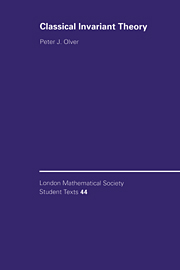Book contents
- Frontmatter
- Contents
- Introduction
- 1 Prelude — Quadratic Polynomials and Quadratic Forms
- 2 Basic Invariant Theory for Binary Forms
- 3 Groups and Transformations
- 4 Representations and Invariants
- 5 Transvectants
- 6 Symbolic Methods
- 7 Graphical Methods
- 8 Lie Groups and Moving Frames
- 9 Infinitesimal Methods
- 10 Multivariate Polynomials
- References
- Author Index
- Subiect Index
3 - Groups and Transformations
Published online by Cambridge University Press: 08 January 2010
- Frontmatter
- Contents
- Introduction
- 1 Prelude — Quadratic Polynomials and Quadratic Forms
- 2 Basic Invariant Theory for Binary Forms
- 3 Groups and Transformations
- 4 Representations and Invariants
- 5 Transvectants
- 6 Symbolic Methods
- 7 Graphical Methods
- 8 Lie Groups and Moving Frames
- 9 Infinitesimal Methods
- 10 Multivariate Polynomials
- References
- Author Index
- Subiect Index
Summary
Following our preliminary foray into the basic ideas of invariant theory, it is now time to understand, in more detail, the mathematical foundations of our subject. Of course, one could continue to focus solely on invariant theory, but the full ramifications of our investigations would remain obscure without a proper appreciation for the underlying, modern mathematical theories, most of which can trace their genesis back to the problems of classical invariant theory itself. This chapter is devoted to a brief survey of the basic theory of transformation groups, starting with the properties of groups themselves. For our purposes, the most important examples are provided by simple actions on a linear space and their projective counterparts. Although our primary focus is on certain infinite, continuous groups, the present chapter will develop the general theory, which includes finite, discrete, infinite, and topological groups. More advanced methods that rely on the additional analytic structure of Lie groups will be postponed until Chapters 8 and 9.
Basic Group Theory
The theory of groups has its origins in the classical work of Lagrange, Abel, and Galois on the solubility of polynomials. (See, for example], for historical surveys of group theory.) These mathematical giants discovered that the symmetries of a geometric object (in their case, the object was the set of roots to a polynomial equation) admit a certain underlying structure, which is crystallized in the definition of a “group”.
- Type
- Chapter
- Information
- Classical Invariant Theory , pp. 44 - 61Publisher: Cambridge University PressPrint publication year: 1999



